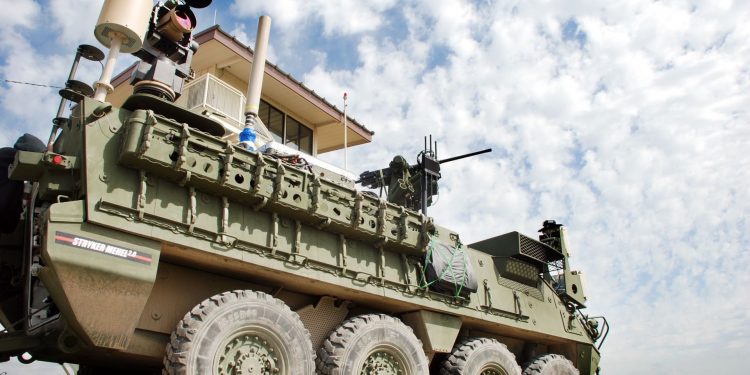Further evaluation of new air defense capabilities is currently underway, including the Integrated Air and Missile Defense Battle Command System and directed energy weapons, as the Army aims to empower units against near-peer threats.
Soldiers from 3rd Battalion, 43rd Air Defense Artillery Regiment and 3rd Bn., 6th Air Defense Artillery Air Missile Defense Test Detachment are involved in a limited user test for the IBCS that started in early July, said Maj. Gen. Robert Rasch Jr., head of the Program Executive Office of Missiles and Space.
The evaluation was initially scheduled for May, but was pushed back about a month due to COVID-19 safety concerns, he added. The Army will complete the current test, which is being held at New Mexico’s White Sands Missile Range, by September.
The 3-43 ADA, a Patriot missile unit, will also be the first unit equipped with the IBCS capability once the limited user test is complete, Rasch said. After the limited test is complete, the equipment and software will be refreshed to support an operational test and evaluation before the unit achieves an initial operational capability in 2022.
The new system will provide the Army with an integrated command-and-control system, capable of blending current and future air and missile defense sensors and weapon systems under a unified network. The limited user test is focused on the baseline requirements for IBCS, including integration of Patriot and AN/MPQ-64 Sentinel components, PEO officials said.
“The Army committed one of its coveted Patriot battalions, which are in high demand across the world given the current [operational] tempo requirements,” Rasch said Aug. 4 during the Space and Missile Defense Symposium.
The battalion is assigned to support the program for the next three years.
The Army looks to bridge its offensive and defensive fires and sensor capabilities to fight and win in a multi-domain battlespace. The IBCS program will create an architecture, allowing for the consistent transmission of information from higher headquarters, all the way down to the operator.
In December, the Army proved the IBCS capability after successfully launching Patriot Advanced Capability-2 missiles to intercept two cruise missile surrogates.
During the evaluation, officials networked between a Marine Corps Ground and Air Task-Oriented Radar and two Air Force F-35 Lightning IIs flying overhead to identify the targets beyond Patriot radar technology, Rasch added.
In addition to the IBCS, the 3-43 ADA will be the first unit to receive the Lower Tier Air and Missile Defense Sensor, or LTAMDS, Rasch said.
The new IBCS networked device is designed to provide the Army with a 360-degree view of the battlespace. The LTAMDS also aims to defeat advanced threats, to include hypersonic weapons, program officials said.
The PEO team is “moving out with the industry partner to provide a prototype” by late fiscal year 2021,” Rasch said. “We will begin testing the system leading up to an urgent material release,” to meet a requirement set by the Army secretary.
The 3-43 ADA will test additional weapons and sensors — such as LTAMDS — within the IBCS architecture, starting in fiscal 2022, PEO officials said.
“This is coming in as an IBCS-enabled radar,” he added. “This radar is going to contribute to the total air picture across all the systems we have, wherever it’s located.”
Directed energy
The Army is also pursuing a variety of directed energy weapons, to include high-energy lasers and high-power microwave systems, said Lt. Gen. Neil Thurgood, director of hypersonics, directed energy, space and rapid acquisition at the Army Rapid Capabilities and Critical Technologies Office.
The RCCTO is charged to field critical enabling technologies that address near- and mid-term threats, ensuring Soldiers have the necessary equipment to fight and win, Thurgood said at the symposium.
“The world has changed over the last 18 or 19 years as we have been fighting the Global War on Terror,” Thurgood said. With the signing of the National Defense Strategy, the Army is now in an era of great power competition against China and Russia, he added.
Currently, the force is working on fielding a Directed Energy-Maneuver Short Range Air Defense capability, or DE-MSHORAD, to the platoon level by fiscal 2022, Thurgood said. The new capability will provide brigade combat teams with a 50-kilowatt laser aboard a Stryker combat vehicle in support of air defense artillery operations.
The Army also looks to field a 300-kilowatt Indirect Fire Protection Capability-High Energy Laser, or IFPC-HEL, and IFPC-High Powered Microwave, or HPM, at the platoon level in support of brigade air defense artillery operations in fiscal 2024, he added.
Directed energy weapons are considered more cost effective, making them a strategic tool in the fight against low-cost weapons found on the modern battlefield.
“At these power levels, I colloquially remind people that we don’t have the ‘Star Wars effect’ — where you put a beam of light out there and a battleship blows up,” Thurgood said. “Directed energy is a very specific weapon for specific outcomes. In our maneuver elements, the DE-MSHORAD is meant to counter small [unmanned aircraft systems], rocket artillery, and mortar fire.”
As brigades move to a more fixed location, personnel can leverage the IFPC-HEL and IFPC-HPM technology. Users will then have the option to sequentially destroy a series of single targets through a high-powered laser, or take out a group of targets through a “cone” of high-powered microwave energy.
Moving forward, the Army will aim to equip its maneuver elements with high-powered microwave capabilities, but must wait for current technology to improve and decrease in size, he said.











